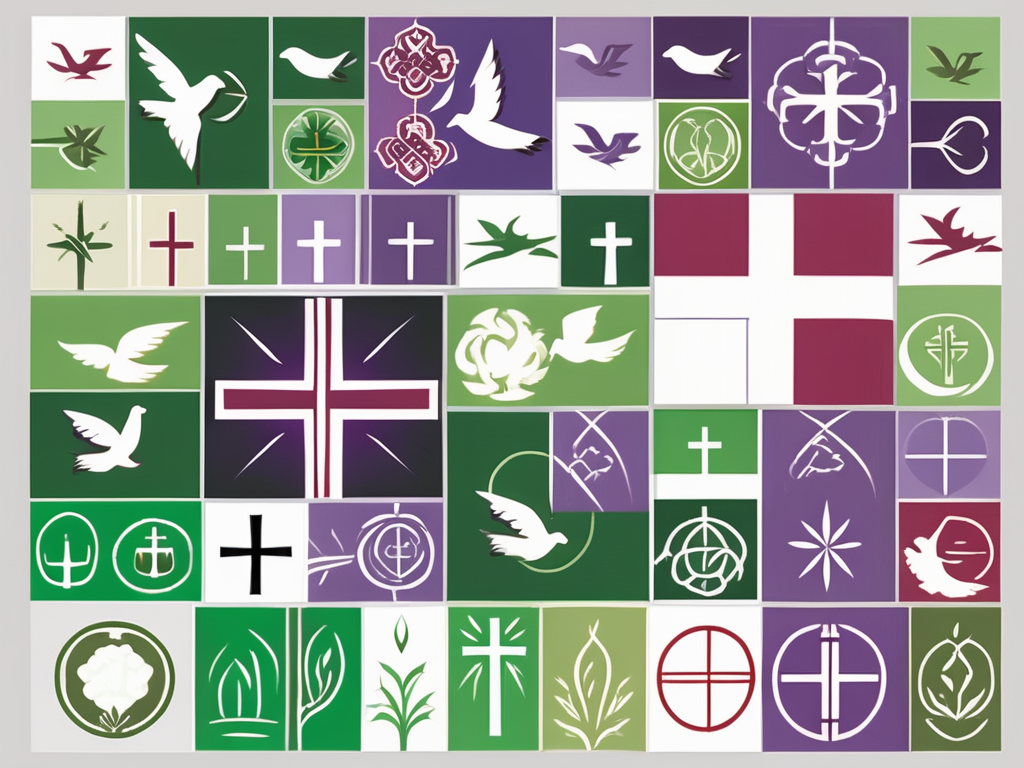In the Bible, colors are often used symbolically to convey deeper meanings and truths. Green is one such color that holds significant symbolism in biblical narratives. Understanding the symbolism of colors can help us gain a deeper appreciation for the messages conveyed in the scriptures.
Understanding the Symbolism of Colors in the Bible
The role of colors in biblical narratives goes beyond mere visual aesthetics. Colors are used to enhance the storytelling and convey spiritual truths. Each color carries its own symbolism, and green is no exception. Let’s delve into the significance of green in general symbolism and its interpretation in the Bible.
The Role of Colors in Biblical Narratives
Colors play a crucial role in biblical narratives, evoking emotions and conveying important messages. They add depth and richness to the stories, helping us connect with the stories on a spiritual level.
When we encounter colors in biblical narratives, we are invited to explore their deeper meanings and symbolism. Colors serve as powerful tools that assist us in understanding the spiritual truths being conveyed. They create a visual language that resonates with our souls, allowing us to grasp the profound messages embedded within the stories.
Just as an artist carefully selects colors to evoke specific emotions and convey particular meanings, biblical authors strategically incorporate colors into their narratives. They understand that colors have the ability to transcend language barriers and speak directly to the human spirit.
Through the use of colors, biblical narratives come alive, engaging our senses and immersing us in the stories. They awaken our imagination and invite us to participate in the unfolding drama, enabling us to experience the spiritual truths in a profound and personal way.
The Significance of Green in General Symbolism
Green is universally associated with nature, growth, fertility, and life. In general symbolism, green color represents renewal, freshness, and vitality. It reminds us of new beginnings and the abundant blessings of God. In the Bible, green is also closely associated with the concept of hope and victory.
When we think of the color green, our minds are often drawn to lush meadows, vibrant forests, and flourishing gardens. These images evoke a sense of life and rejuvenation. The color green symbolizes the cycle of growth and renewal that is inherent in nature.
In the context of biblical narratives, green serves as a powerful symbol of God’s faithfulness and provision. It reminds us that just as the earth is continually renewed and sustained by God’s hand, so too are our lives. Green represents the promise of new beginnings and the assurance of God’s abundant blessings.
Furthermore, green is closely associated with the concept of hope. It serves as a visual reminder that even in the midst of challenges and hardships, there is always the possibility of a brighter future. Green represents the unwavering belief that God’s promises will be fulfilled and that victory is within reach.
As we encounter the color green in biblical narratives, we are invited to reflect on the themes of growth, renewal, and hope. It serves as a gentle reminder that no matter what we may be facing, God is always at work, bringing forth new life and guiding us towards a future filled with His blessings.
The Biblical Interpretation of Green
The Bible contains numerous references to the color green, both in the Old and New Testaments. These references provide insights into how green is interpreted within the biblical context.
Green, a color often associated with nature and life, holds significant symbolism in the biblical narrative. It represents various themes such as provision, abundance, growth, and spiritual vitality.
Green in the Old Testament
In the Old Testament, green is often used to describe lush vegetation, especially in relation to fertile lands and flourishing crops. It symbolizes God’s provision, abundance, and the joy of His people.
One notable example is found in the book of Psalms, where the psalmist compares the righteous to a flourishing palm tree, stating, “The righteous flourish like the palm tree and grow like a cedar in Lebanon” (Psalm 92:12). Here, the imagery of the palm tree’s green leaves and sturdy growth reflects the prosperity and strength of those who trust in God.
Additionally, the book of Jeremiah speaks of the righteous being “like a tree planted by water, that sends out its roots by the stream, and does not fear when heat comes, for its leaves remain green” (Jeremiah 17:8). This vivid description portrays the resilience and sustenance that God provides to His people, even in challenging times.
Green in the New Testament
In the New Testament, green is less frequently mentioned specifically as a color but is implied through various teachings and parables. The concept of spiritual growth and bearing fruit is associated with the color green, emphasizing the importance of living a fruitful and abundant life in Christ.
Jesus often used agricultural metaphors to convey spiritual truths, and the color green is implicitly present in these teachings. In the parable of the sower, Jesus compares the growth of the Word of God in people’s hearts to the growth of seeds in different types of soil (Mark 4:1-20). The image of the seeds sprouting and producing green shoots represents the transformative power of God’s Word in the lives of believers.
Furthermore, the apostle Paul encourages the Galatians to “not grow weary of doing good, for in due season we will reap, if we do not give up” (Galatians 6:9). This exhortation highlights the importance of perseverance and spiritual growth, which can be symbolized by the color green. Just as plants need time to grow and bear fruit, believers are called to patiently cultivate their faith, trusting that God will bring about a harvest in His perfect timing.
Overall, the biblical interpretation of green encompasses themes of provision, abundance, growth, and spiritual vitality. It serves as a reminder of God’s faithfulness and the importance of cultivating a flourishing relationship with Him.
The Spiritual Significance of Green
Green holds deep spiritual significance in the Bible, representing essential aspects of faith and spirituality.
Green is not just a color; it is a symbol that carries profound meaning and significance in various religious and spiritual contexts. In the Bible, green is often associated with life, fertility, hope, and victory. Let us explore these symbolic representations in greater detail.
Green as a Symbol of Life and Fertility
Green symbolizes the gift of life and the flourishing of God’s creation. Just as plants and trees thrive in green, our spiritual lives can also thrive when rooted in God’s love and nourished by His Word. The color green reminds us of the abundant grace and provision that sustains all living things.
When we look at the lush greenery of nature, we witness the beauty of God’s creation. It serves as a constant reminder of His faithfulness and the intricate balance He has established in the natural world. Green represents the cycle of life, from the sprouting of seeds to the growth of plants, and ultimately, the fruition of abundant harvests.
Furthermore, green is often associated with fertility. In many cultures, the color green is connected to the idea of growth, both in terms of physical fertility and spiritual abundance. It symbolizes the ability to bring forth new life, whether it be in the form of children, ideas, or spiritual growth.
Green as a Symbol of Hope and Victory
Green is also frequently associated with hope and victory. It serves as a beacon of light in times of darkness, reminding us of the promises of God. Just as the arrival of spring brings forth new life and hope after the cold winter months, the color green represents the triumph over adversity and the assurance of a better tomorrow.
During moments of trials and challenges, green serves as a constant reminder that we are not alone. It encourages us to persevere, knowing that God’s faithfulness will guide us through the darkest of times. Green represents the unwavering hope that springs forth from our faith, reminding us that there is always light at the end of the tunnel.
Moreover, green symbolizes victory over sin and death. Through the sacrifice of Jesus Christ, we have been granted eternal life and the hope of salvation. The color green reminds us of the victory we have in Christ and the assurance of a future filled with joy and peace.
In conclusion, the spiritual significance of green is multi-faceted and rich in symbolism. It represents the gift of life, the flourishing of God’s creation, and the hope and victory we have in Him. As we reflect on the color green, may it serve as a constant reminder of God’s faithfulness and the abundant blessings He bestows upon us.
The Use of Green in Biblical Prophecy
Biblical prophecies are filled with vivid imagery, including references to the color green. These prophecies provide insights into the future and the fulfillment of God’s plans.
Green, a color often associated with nature and life, holds significant symbolism in the context of biblical prophecy. It represents growth, abundance, and the renewal of all things. Just as plants and trees flourish in vibrant green, so too does the spiritual realm in the prophecies found within the Bible.
Green in the Book of Revelation
In the book of Revelation, green is mentioned in various prophecies, symbolizing the flourishing of God’s kingdom and the restoration of all creation. It portrays the everlasting life and spiritual renewal that awaits believers in the presence of God.
One such instance is found in Revelation 22:2, where it describes the tree of life bearing twelve kinds of fruit, yielding its fruit every month. The leaves of this tree are said to be for the healing of the nations, and it is no coincidence that these leaves are depicted as green. This imagery conveys the idea of complete restoration and the abundant provision of God for His people.
Furthermore, in Revelation 8:7, green is associated with the third trumpet judgment, where a great burning mountain is cast into the sea, turning a third of the waters into blood. The green grass is also affected by this judgment, highlighting the impact of sin and judgment on the natural world. However, even in the midst of destruction, the mention of green grass reminds believers that God’s redemptive plan will ultimately bring about restoration and renewal.
Green in the Prophetic Visions
Prophetic visions often contain elements of green, signifying the restoration and transformation of God’s people and the world. The color green serves as a reminder of the hope and ultimate victory that believers will experience through the redemptive work of Jesus Christ.
One notable example is found in the vision of Ezekiel, where he sees a valley filled with dry bones. These bones represent the exiled Israelites, who had lost hope and were spiritually dead. However, as Ezekiel prophesies, the bones come together, sinews and flesh cover them, and breath enters them, bringing them back to life. This vision of restoration and revival is accompanied by the mention of greenness, symbolizing the rejuvenation of God’s people and the renewal of their relationship with Him.
Another prophetic vision that incorporates the color green is found in the book of Zechariah. In Zechariah 1:8-17, the prophet sees a man riding on a red horse among the myrtle trees in a valley. The myrtle trees, with their green leaves, represent the people of God who have been scattered and oppressed. However, the vision reveals that God’s favor and protection will be restored to His people, and they will once again flourish like the green myrtle trees.
As believers reflect on the significance of green in biblical prophecy, they are reminded of the hope and assurance they have in God’s promises. Just as green represents growth, abundance, and renewal, so too does the fulfillment of biblical prophecies bring about the flourishing of God’s kingdom and the restoration of all creation.
Green in Parables and Teachings of Jesus
Jesus often used parables and teachings to convey spiritual truths, and green color is occasionally referenced in these teachings.
The Fig Tree Parable
In the fig tree parable, Jesus used the concept of a green and flourishing fig tree to illustrate the signs of His second coming. Just as the appearance of green leaves indicates the arrival of summer, the signs of His return will be evident to those who are watchful and discerning.
The Teaching on the Lilies of the Field
Jesus’s teaching on the lilies of the field emphasizes the beauty and provision of God. The vibrant green of the lilies serves as a reminder of how God cares for even the smallest details of our lives and encourages us to trust in His divine provision.
As we explore the symbolism of colors in the Bible, we discover that green holds a significant place in conveying spiritual truths. From representing life, fertility, and hope to being intertwined with biblical prophecies and Jesus’s teachings, the color green serves as a powerful reminder of God’s abundant blessings and faithfulness. May we always be mindful of the deeper meanings embedded within the colors of the scriptures, allowing them to strengthen our faith and deepen our understanding of God’s plan for our lives.












